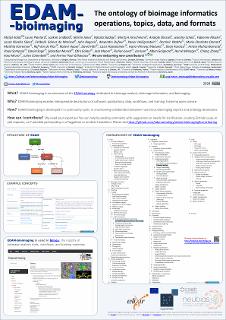EDAM-bioimaging: the ontology of bioimage informatics operations, topics, data, and formats (update 2020)
Kalaš, Matúš; Plantard, Laure; Lindblad, Joakim; Jones, Martin; Sladoje, Nataša; Kirschmann, Moritz A.; Chessel, Anatole; Scholz, Leandro; Rössler, Fabianne; Nicolás Sáenz, Laura; Gómez de Mariscal, Estibaliz; Bogovic, John; Dufour, Alexandre; Heiligenstein, Xavier; Waithe, Dominic; Domart, Marie-Charlotte; Karreman, Matthia; Van de Plas, Raf; Haase, Robert; Hörl, David; Paavolainen, Lassi; Vrhovac Madunić, Ivana; Karaica, Dean; Muñoz-Barrutia, Arrate; Sampaio, Paula; Sage, Daniel; Munck, Sebastian; Golani, Ofra; Moore, Josh; Levet, Florian; Ison, Jon; Gaignard, Alban; Ménager, Hervé; Zhang, Chong; Miura, Kota; Colombelli, Julien; Paul-Gilloteaux, Perrine
Others
Published version

Åpne
Permanent lenke
https://hdl.handle.net/11250/2986090Utgivelsesdato
2020Metadata
Vis full innførselSamlinger
- Department of Informatics [978]
- Registrations from Cristin [10237]
Sammendrag
EDAM is a well-established ontology of operations, topics, types of data, and data formats that are used in bioinformatics and its neighbouring fields [1,2] . EDAM-bioimaging is an extension of EDAM dedicated to bioimage analysis, bioimage informatics, and bioimaging. It is being developed in collaboration between the ELIXIR research infrastructure and the NEUBIAS and COMULIS COST Actions, in close contact with the Euro-BioImaging research infrastructure and the Global BioImaging network. EDAM-bioimaging contains an inter-related hierarchy of concepts including bioimage analysis and related operations, bioimaging topics and technologies, and bioimage data and their formats. The modelled concepts enable interoperable descriptions of software, publications, data, workflows, and training materials, fostering open science and "reproducible" bioimage analysis. New developments in EDAM-bioimaging at the time of publication [3] include among others: A concise but relatively comprehensive ontology of Machine learning, Artificial intelligence, and Clustering (to the level relevant in particular in bioimaging, biosciences, and also scientific data analysis in general) Added and refined topics and synonyms within Sample preparation and Tomography, and finalised coverage of imaging techniques (all of these to the high-level extent that influences choices of downstream analysis, i.e. the scope of EDAM) EDAM-bioimaging continues being under active development, with a growing and diversifying community of contributors. It is used in BIII.eu, the registry of bioimage analysis tools, workflows, and training materials, and emerging also in descriptions of Debian Med packages available in Debian and Bio-Linux, and tools in bio.tools. Development of EDAM-bioimaging has been carried out in a successful open community manner, in a fruitful collaboration between numerous bioimaging experts and ontology developers. The last stable release at the time of poster publication is version alpha06 [3], and the live development version can be viewed and commented on WebProtégé (free registration required). New contributors are warmly welcome! [1] Ison, J., Kalaš, M., Jonassen, I., Bolser, D., Uludag, M., McWilliam, H., Malone, J., Lopez, R., Pettifer, S. and Rice, P. (2013). EDAM: an ontology of bioinformatics operations, types of data and identifiers, topics and formats. Bioinformatics, 29(10): 1325-1332. DOI: 10.1093/bioinformatics/btt113 Open Access [2] Kalaš, M., Ménager, H., Schwämmle, V., Ison, J. and EDAM Contributors (2017). EDAM – the ontology of bioinformatics operations, types of data, topics, and data formats (2017 update) [version 1; not peer reviewed]. F1000Research, 6(ISCB Comm J):1181 (Poster) DOI: 10.7490/f1000research.1114459.1 Open Access [3] Matúš Kalaš, Laure Plantard, Martin Jones, Nataša Sladoje, Marie-Charlotte Domart, Matthia Karreman, Arrate Muñoz-Barrutia, Raf Van de Plas, Ivana Vrhovac Madunić, Dean Karaica, Laura Nicolás Sáenz, Estibaliz Gómez de Marisca, Daniel Sage, Robert Haase Joakim Lindblad, and all contributors to previous versions (2020). edamontology/edam-bioimaging: alpha06 (Version alpha06). Zenodo. DOI: 10.5281/zenodo.3695725 Open Access
